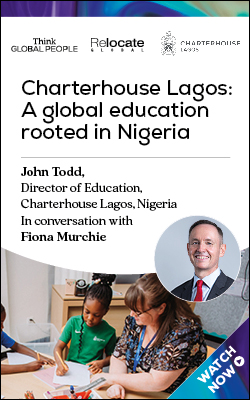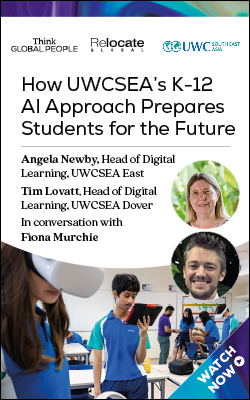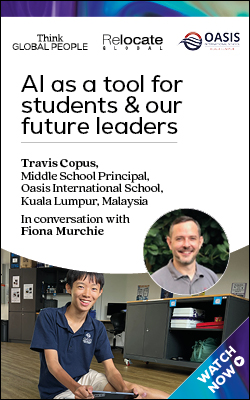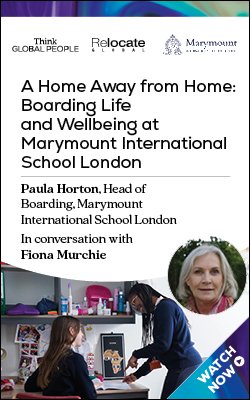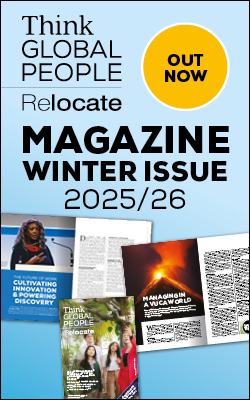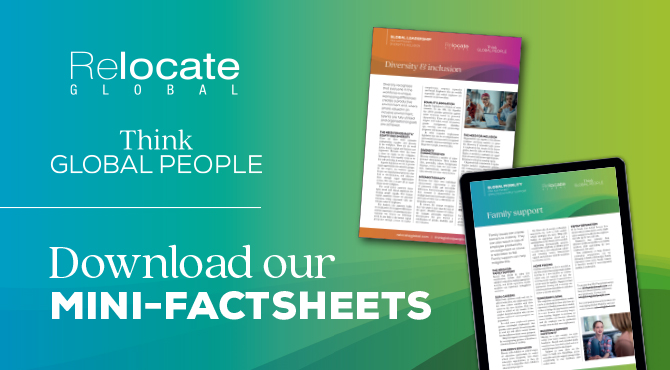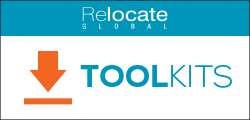The Future of Work: Cultivating Innovation and Powering Discovery
At this year’s CIPD Annual Conference and Exhibition, Anne-Marie Imafidon MBE, the mathematician and STEM advocate, encouraged delegates to harness the possibilities that the future of work might hold and urged each one of us to play our part

Dr Anne-Marie Imafidon MBE, speaking at the CIPD annual conference
View your copy of the Winter 2025/26 issue of Think Global People magazine
Click on the cover to access the digital edition.
Dr Anne-Marie Imafidon MBE, Mathematician and STEM Advocate, speaking as the keynote for the CIPD’s annual conference in Manchester, claimed that the future of work is happening here and now, and everyone has the opportunity to help shape how we interact with technology and how we progress in an equitable way. This is important because human resources is uniquely placed to help design the ethical use of technology in the workplace. By setting expectations around fairness, transparency, and accountability, HR can turn Artificial Intelligence from a disruptor into a partner for progress, she told delegates.“We do have a voice. We do have a space to operate,” she said. “Because HR covers recruitment, culture, and wellbeing, it needs to engage with the debate around how technology can be ethically and effectively introduced into organisations. “You have quite a lot of influence to ask these questions, to challenge at the right time,” she said, “so that then 50 years down the line, we can be proud of the decisions that we made.”
Cultivating Innovation, Powering Discovery
To emphasise her connection with CIPD, she subtitled her talk The future of work: how to lead, adapt and innovate for what’s next, as Cultivating Innovation, Powering Discovery (CIPD) in order to emphasise her vision for what the future of work might look like. As chair at the Institute for the Future of Work, much of the work she does is in collaboration with CIPD, she said, describing how she first became interested in maths and machines as a young child.“Some of my earliest memories were around machines and different devices that we had at home. I was fascinated by the washing machine, and the VCR player. “We had stacks and stacks of VCR tapes at home,” she said. “I remember being obsessed with them.” This led to experimentation, taking apart the VCR in search of answers, and led to Imafidon’s second point – that curiosity, when disciplined and nurtured in the right way, is the engine of progress. Yet as she warns, “as adults, this is something that kind of gets beaten out of us, gets disincentivised the older we get.”Building a movement to empower women: From STEM to STEAM
In 2013, Imafidon founded Stemettes, a social enterprise dedicated to empowering girls, young women, and non-binary people in science, technology, engineering, and mathematics. She soon expanded the acronym—adding “Art” to form STEAM.“Art and Design is the true heart of innovation,” she said, explaining that the programme now serves participants aged five to twenty-five. The youngest participants, however, symbolise a deeper question—how can we shape the imagination of the next generation for a world fifty years away?Looking fifty years ahead
“I’ve ended up becoming a little bit more obsessed with the future than maybe the typical person,” Imafidon admitted. She invited her audience to take a speculative journey beyond quarterly planning and five-year strategies into a world half a century away.Her description of a futuristic cityscape with flying cars and AI integration was a reminder that many of tomorrow’s realities begin as today’s prototypes, for example we now talk to our cars in a way that would have belonged to the realms of sci-fi forty years ago. Between the 1980s fiction and the present lies decades of incremental innovation, what she called a “slow march” that shows how imagination, persistence, and design converge over time.Imagining future frontiers of work
Imafidon’s vision of the next half-century encompasses radical technological evolution and but also human dilemmas.“AI is not the only piece of the puzzle,” she said. “What might be happening for the person sat in your seat in 50 years’ time? Many of the desires and the imaginations and the designs that we're putting forward today end up becoming a reality.”She cited the example of the role AI has to play in medical diagnosis, how it can review historic legal cases to gain new insights. More controversially, AI can compose music and be creative. AI might also change the role of logistics, in that you would 3D print an item on your local high street, rather than pay for it to be manufactured and shipped from overseas, or you might create renewable clothing which could be composted when no longer needed.Yet she warned that we need to be aware of the complications of this rapid progress: “We still haven’t quite learned the lesson, especially in the context of technology, around inclusivity, conscience, and foresight.”Inclusion must be built into designs, rather than added on later, she said. It was important to have input from a variety of voices. Otherwise, the absence of diverse ideas could mean bias in algorithms and products which don’t meet the needs of the end user.She gave some examples of design and product failures which exposed a gap between technological ability, moral responsibility, and usefulness, for example a period tracker which only tracked a woman’s menstrual cycle for ten days, and crash test dummies which only replicated adult male bodies, neglecting to text impacts on women and children. Through research and collaboration with organisations like CIPD, the Institute for the Future of Work is trying to ensure that the technologies transforming work do so for good, and actually benefit the end user, as well as taking the needs of all different user groups into account.Yet AI can have its disadvantages, especially if introduced quickly and allowed to run unchecked. She described one illustrative case from retail, where AI was deployed to “optimise and reduce running costs.” Initially, the tool was viewed as efficient and impartial until biases began to surface. Patterns emerged which included erratic shift patterns, a widening pay gap and one demographic consistently favoured for promotions.To counter such trends, the Institute introduced the Good Work Charter, an ethical framework for aligning digital transformation with human dignity. In her closing remarks, Imafidon addressed HR professionals directly. “None of this is inevitable,” she emphasised. “We have to be more vigilant. We do have a voice. We do have a space to operate.”Read related articles
- What technology can and cannot replace - the human factor that drives performance
- Global Mobility in transition: navigating compliance, technology, and the future of work
- The path to AI empowerment
- Winner of Excellence in technology or analytics Award 2025
- The shape of mobility to come: strategy, technology, and leadership in a disrupted world
Rapid changes in geopolitics and technology
In his opening speech Peter Cheese, chief executive of the CIPD, announced that he will be retiring from the role in June 2026 after fourteen years of service. He used his speech to think about what the future of the profession might hold, and what the future of work might look like.“I've always been fascinated and curious about the future,” he said. “One of my favourite quotes by science fiction writer William Gibson is that the future is already here, it is just unevenly distributed.” He described the rapid change which we are all seeing in work and across the globe.“In 40 years in business I have never seen so much geopolitical change,” he told delegates. “We seem to be moving from a world that was on a path towards globalisation to one where it seems to be more about protectionism and rowing back on some of the principles which are driving businesses for a long time now.”He said that trend had impacted the structure of organisations, their supply chains, where they get the skills and capabilities from, and what markets that they can work in, as well as economic change which is putting a lot of pressure on businesses everywhere, and social change.“The world of work is as much about the social connections we have as it is about the work connections,” he said, “and understanding the context of social change and how we adapt our organisational cultures to respond to this and to technology.”He said AI integration into systems, and the rise of generative AI, was impacting the nature of work and the jobs that we do, and that people and professions would need to change and adapt.“It is impacting the nature of our workplaces, and the kind of organisations that we need to create for the future which are agile and adaptive, and the very nature of work itself,” he said.The workforce is also going to have to adapt to a future which is progressing very quickly at a time when organisations are also attempting to deal with economic uncertainties and cut costs. This is where the role of training, upskilling and people management has become so vital.“We should understand the interventions that we are making and how they do drive business outcomes,” he said. “We are trying to understand the skills and capabilities the workforce will need for the future, and what are the frameworks that will help people implement AI ethically and responsibly? This is not a one way street. We have agency in influencing the future of work.”To sum up, he said that the best way to predict the future is to shape it.“This is a collective debate about our future as a profession and our ability and agency in shaping the future of work,” he said.A future technology with the potential to be democratic
While AI offers huge opportunities for progress, it also needs to be implemented with care and thought. Speaking on a panel with Peter Cheese, Professor Chris Bones, Chair of the CIPD Board, said that AI large language models are the first technological innovation that is “entirely democratic”.“People can access it, they can use it, and it can be hugely powerful, and there are places where it iso making an amazing impact, for example in medical research, or the ability to diagnose problems really quickly and get people into treatment in health services.”However, he warned that it came with “major challenges”. “How do we know the application that someone has written for a job is actually written by them?” he asked. “How do we know that the submission someone has put in for a professional examination is actually them? How do we know when someone is in court answering the question of a judge, that they are not using a prompt in front of them that is giving them AI slop or hallucinations that could wrongly direct the force of justice?”He said that in some ways technology is going to automate, excite and provide opportunities for pace and change, but that it is also going to change the role of people and personnel in organisations.“It is also going to transform jobs and work in many ways that I think we are still trying to understand,” he added. “One of the things I think it is going to do is create a lot of new jobs, and that is the job of checking and quality assuring and making sure we are not in legal trouble, professional trouble, or any sort of other trouble, because we haven't really evaluated what is coming out of the machine.”In other words, AI can be useful, but only if there is a human evaluating its outputs, checking for mistakes and bias, and understanding its value and also its limitations.“How do we help organisations create operating models that integrate AI visibly, transparently and openly into everything they do?” he said. “As a profession, the important thing is to upskill ourselves very quickly.”Rt Hon Chloe Smith, President of the CIPD, said that she was particularly excited by “the strategic opportunity” that was opening up with technology occurring now in a bigger, faster, stronger way than before.“The key point is this we have a chance to ensure that our work now moves into a new strategic space, and the technology will be there available to help many of us do that,” she said. “It will be applicable in both our operational roles and everything all the way across the strategic spectrum. It will mean the ability for each one of us in this room to do more to achieve our business outcomes, to do more to achieve success in our particular organisation.”In his closing remarks, Peter Cheese emphasised the importance of collaboration in building a future world of work that provides opportunities for everyone in the workplace.“Collaboration, to me, has always been critical, and I think always will be in a very fast moving world, because we cannot solve the world's challenges and opportunities only by looking through one lens,” he said. “It is about holistic and systemic thinking.”He also stressed the value of stewardship.“What I hope and believe I have done, and what any leader should do, is to leave what they inherited in a better place, so it is fit for the future, and then we can continue to drive forwards on the things that we feel strongly and passionate about,” he said.In summary, the future is both exciting and daunting, and organisations need to think strategically about how and why they implement new technologies. There is a role for both AI and people in this new world, and we all have the opportunity to shape it and collaborate in it to ensure that the workplace of the future is one in which people are fulfilled and enabled.

Find out more about the Think Global People and Think Women community and events.

Subscribe to Relocate Extra, our monthly newsletter, to get all the latest international assignments and global mobility news.Relocate’s new Global Mobility Toolkit provides free information, practical advice and support for HR, global mobility managers and global teams operating overseas.
©2025 Re:locate magazine, published by Profile Locations, Spray Hill, Hastings Road, Lamberhurst, Kent TN3 8JB. All rights reserved. This publication (or any part thereof) may not be reproduced in any form without the prior written permission of Profile Locations. Profile Locations accepts no liability for the accuracy of the contents or any opinions expressed herein.








